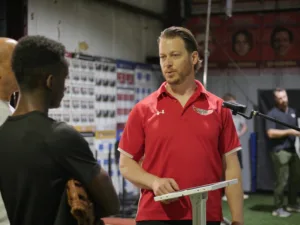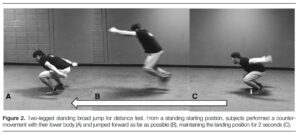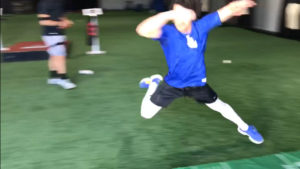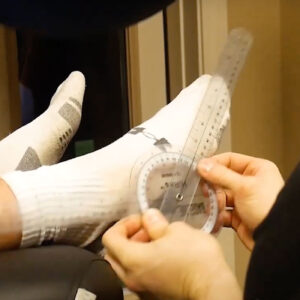In the competitive world of baseball, where milliseconds can make the difference between a win and a loss, optimizing athletic performance through evidence-based training is crucial. One of the most effective methods for gauging and enhancing an athlete’s progress is through weight room assessments. This article will explore the significance of vertical jumps, broad jumps, and lateral jumps, and how these metrics can provide valuable insights into an athlete’s development and readiness on the field.
The Importance of Weight Room Assessments
Weight room assessments are critical tools for understanding an athlete’s physical capabilities and tracking their progress over time. These assessments help identify strengths and weaknesses, allowing for the customization of training programs to meet individual needs. For baseball players, who require a unique blend of power, agility, and endurance, specific jump assessments can be particularly revealing.
Weight room assessments serve several purposes:
- Tracking Progress: Regular assessments provide objective data to monitor improvements in strength, power, and agility.
- Identifying Weaknesses: By pinpointing areas that need development, coaches can tailor training programs to address specific deficiencies.
- Preventing Injuries: Understanding an athlete's physical limits and weaknesses helps in designing training regimens that minimize the risk of injury.
- Enhancing Performance: Targeted training based on assessment results can lead to significant improvements in on-field performance.
The following sections will delve into the three primary jump assessments—vertical jumps, broad jumps, and lateral jumps—and their relevance to baseball training.
The Relevance of Vertical Jumps, Broad Jumps, and Lateral Jumps in Baseball Training
The conventional response to statements like "Jump Farther, Throw Harder" or "Lift Heavier, Throw Harder" is often skeptical. Critics argue that just because an athlete can jump high or lift heavy weights, it doesn’t necessarily mean they can throw a baseball with high velocity. For instance, why couldn't Michael Jordan, known for his exceptional vertical leap, throw a baseball at 95 mph during his stint in minor league baseball? The answer lies in understanding motor coordination.
Motor Coordination and Baseball Performance
Motor coordination is the harmonious combination of body movements that are crafted with kinematic (spatial direction) and kinetic (force) parameters, resulting in precise and intended actions. This intricate dance of movement is something that elite athletes, like Michael Jordan and Olympians, spend their entire careers perfecting within the context of their specific sports. For instance, a basketball player like Jordan develops a unique set of motor skills tailored to the demands of basketball, such as dribbling, shooting, and vertical leaping.
Transitioning to another sport, such as baseball, requires a complete reprogramming of these motor coordination patterns. This reprogramming is not instantaneous; it can take years of dedicated practice to achieve the same level of proficiency. Michael Jordan's journey in minor league baseball highlights this challenge. Despite his extraordinary athletic abilities, he struggled initially, underscoring the specificity of motor coordination. His gradual improvement over time demonstrated how critical it is to develop sport-specific motor skills through persistent and focused practice.
In the context of pitching, continued practice of the proper sequencing of the pitching delivery is crucial for achieving better motor control and maximum force production. The pitching delivery involves a complex series of movements, from the wind-up to the follow-through, each requiring precise coordination and timing. Regular practice helps to engrain these movements into muscle memory, allowing the athlete to execute them with greater efficiency and power.
As pitchers consistently practice the correct sequence, their body begins to move more fluidly and with greater control. This improved motor control translates into more consistent and accurate pitches. Additionally, the enhanced coordination allows pitchers to generate more force efficiently, maximizing their velocity and reducing the risk of injury. Over time, this dedicated practice leads to the refinement of their technique, enabling them to perform at their peak potential.
Vertical Jumps: Measuring Explosive Power
Now that we understand how motor coordination effects performance, we can delve into the details on how to properly use weight room assessments to track progress and why. Vertical jumps are a critical weight room assessment for baseball players. This test measures an athlete’s ability to generate explosive power from a stationary position. In baseball, this translates to quicker reactions and more powerful movements, whether it’s sprinting to first base, making a leap to catch a high fly ball, or delivering a pitch with maximum velocity.
Study Insight:
A study titled "The Relationship Between Power and Lean Body Mass to Sport-specific Skills of College Baseball Players" found a moderately positive relationship between vertical jump performance and bat velocity (r = 0.58). This indicates that players who can jump higher tend to have greater bat speed. Additionally, for pitchers, the explosive power measured by vertical jumps is directly linked to their ability to generate forceful, high-velocity pitches.
Broad Jumps: Enhancing Explosive Strength and Distance
Broad jumps, or standing long jumps, are an incredibly effective tool for assessing weight room progress because they provide a clear measurement of an athlete's explosive power and lower body strength. This exercise involves an athlete propelling themselves forward from a standing position, which directly mirrors the explosive movements required in running, throwing, and pitching. For baseball players, this test is particularly relevant as it helps gauge their ability to generate power quickly and efficiently. By regularly performing and measuring broad jumps, athletes can track improvements in their strength and power, identifying gains made through their weight room training. Additionally, consistent broad jump assessments can help pinpoint areas needing further development, ensuring that training programs remain focused and effective. This continuous feedback loop is crucial for optimizing performance and achieving peak athletic ability on the field.
Study Insight:
The same study revealed a strong correlation between broad jump performance and sprint acceleration (r = 0.70). This suggests that players who perform well in the broad jump are likely to be faster runners. For pitchers, the broad jump's emphasis on forward explosive strength is crucial for generating momentum and power in their pitching delivery.
Lateral Jumps: Building Agility and Lateral Power
Lateral jumps are a vital tool for measuring an athlete’s lateral explosive power and agility. This exercise requires an athlete to jump side-to-side, assessing their ability to generate power and move quickly in lateral directions. In baseball, lateral quickness is essential for numerous aspects of the game. Fielding ground balls, for instance, demands rapid lateral movements to reach the ball efficiently. Quick pivots, often required when transitioning from catching to throwing or moving between bases, rely heavily on lateral agility. Additionally, maintaining balance during high-speed movements, such as stealing bases or reacting to plays, is crucial for optimal performance on the field.
For pitchers, lateral explosive power is particularly important. The ability to make rapid lateral movements can enhance a pitcher’s delivery, allowing them to generate more power and accuracy in their throws. The same study highlighted the importance of rotational power, measured through the medicine ball side toss, showing significant positive relationships with throwing velocity (r = 0.49) and bat velocity (r = 0.50). This demonstrates that lateral jumps and rotational power are vital for activities requiring rapid, multi-directional movements and force generation, which are essential for both hitting and pitching. By incorporating lateral jumps into their training regimen, athletes can improve their overall agility, enhance their ability to perform complex fielding maneuvers, and boost their pitching performance.
Regular assessment of lateral jumps provides valuable feedback on progress and identifies areas needing further development, ensuring that athletes can continually refine their skills and maintain peak performance. By focusing on improving lateral explosive power and rotational strength, athletes can achieve significant gains in their on-field performance, making them more effective and versatile players.
Real-World Examples and Athletic Training
Several elite pitchers exemplify how athletic training can enhance pitching performance. Tim Lincecum, a two-time Cy Young Award winner, is renowned for his explosive athleticism despite his relatively small stature. His teammate Mark DeRosa noted Lincecum's impressive performance in agility tests, including the standing broad jump and vertical leap, highlighting how these attributes translate to his pitching prowess. Lincecum’s ability to generate explosive power and lateral agility directly contributes to his pitching success.
Similarly, Tim Collins transformed himself from a 131-pound high school senior with an 82-mph fastball to a 172-pound major league pitcher with a 93-mph fastball. His training regimen focused on developing lower body strength, core strength, and lean body mass, demonstrating how targeted strength training can significantly enhance pitching velocity.
Assessing Weightroom assessments
The evidence is clear: enhancing vertical jumps, broad jumps, and lateral jumps through targeted weight room assessments can significantly improve baseball performance. These assessments provide valuable insights into an athlete’s explosive power and agility, guiding the development of personalized training programs that enhance strength, speed, and overall athleticism. By integrating these assessments into their training routines, baseball players, including pitchers, can achieve greater success and reduce the risk of injury on the field.
Comprehensive Weightroom Assessments at Top Velocity: Beyond Basic Metrics
While basic assessments like broad jumps, lateral jumps, and vertical jumps are valuable tools for identifying athletic weaknesses, they represent only the tip of the iceberg. At Top Velocity, we take a much more comprehensive approach to evaluating our athletes, using over 60 biomechanical markers in every evaluation. This ensures that no weakness goes unnoticed, providing a complete picture of an athlete’s performance and potential areas for improvement.
For athletes who may not have access to our advanced evaluation system, basic metrics such as the broad jump, lateral jump, and vertical jump are excellent starting points. These simple tests can help identify general strengths and weaknesses, offering a foundation for further development. While these basic assessments are beneficial, they only scratch the surface of an athlete’s potential.
Top Velocity’s Comprehensive Evaluation System
At Top Velocity, we believe in going beyond these basic metrics. Our evaluation system involves over 60 biomechanical markers, offering a detailed and thorough analysis of an athlete’s performance. This comprehensive approach allows us to:
- Detect Subtle Weaknesses: By examining a wide range of biomechanical markers, we can identify even the smallest areas of improvement that might be missed with simpler tests.
- Optimize Movement Efficiency: Detailed analysis helps in refining movement patterns to ensure maximum efficiency and power generation.
- Prevent Injuries: Comprehensive evaluations can reveal potential injury risks, allowing for proactive measures to be taken.
- Personalize Training Programs: With a full understanding of an athlete’s biomechanics, we can create highly customized training regimens that address specific needs and goals.
The Importance of Regular Retesting
We encourage our athletes to retest every 4 weeks. Regular retesting is vital to ensure continuous progress and to adjust training programs based on the latest data:
- Track Progress: Frequent evaluations allow athletes to see their improvements over time, providing motivation and clear evidence of their hard work paying off.
- Identify Plateaus: Regular assessments help in recognizing when an athlete has hit a plateau, enabling timely adjustments to push past it.
- Customize Training: Ongoing evaluations ensure that training programs can be continuously tailored to address current strengths and weaknesses.
- Prevent Injuries: Regular monitoring helps in early detection of any biomechanical issues that could lead to injuries.
Conclusion
While basic metrics like broad jumps, lateral jumps, and vertical jumps are valuable starting points, they are just the beginning. At TopVelocity, our comprehensive evaluation system, utilizing over 60 biomechanical markers, ensures that no weakness goes unnoticed. This detailed approach allows for personalized and effective training programs, leading to continuous progress and peak performance. For those without access to our advanced system, starting with these basic metrics can still provide significant insights and drive improvement.
If you are interested in obtaining a comprehensive evaluation and personalized programming to optimize your performance, we highly recommend checking out our 3X Velocity Camp for pitchers and our 2X Velocity Camp for position players. These camps are designed to help you refine your skills, enhance your athleticism, and achieve peak performance. Softball players, we haven’t forgotten about you! We have a specialized program tailored to meet your needs as well. Simply use one of the provided links to sign up and mention in the notes that you are attending the softball camp. We look forward to helping you reach your maximum potential and dominate on the field!








